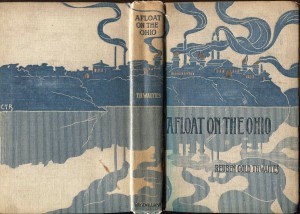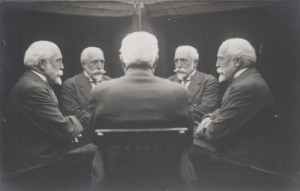 We recently acquired a travel narrative of the Ohio River issued with this fabulous cover, written by Reuben Gold Thwaites, a Massachussets native who moved to Wisconsin in 1866 and became the director of the state historical society, as well as a noted historian (famously editing the monumental, 73-volume Jesuit Relations, relating to their missions to the natives of North America).
We recently acquired a travel narrative of the Ohio River issued with this fabulous cover, written by Reuben Gold Thwaites, a Massachussets native who moved to Wisconsin in 1866 and became the director of the state historical society, as well as a noted historian (famously editing the monumental, 73-volume Jesuit Relations, relating to their missions to the natives of North America).
In January of 1895 this book, Afloat on the Ohio, was in manuscript, and he was shopping around for a publisher. We have two letters from Thwaites in our Robert’s Brothers collection, the first of which, dated 18 January 1895, addressed to Messrs. Roberts Brothers, begins:
Gentlemen: I am sending you today, prepaid, by American Express, the MS of a new book I have just completed–“Afloat on the Ohio.” My other two books built on the same lines–“Historic Waterways” [1888] and “Our Cycling Tour in England” [1892] were published by Messrs. McClurg & Co., Chicago; but I thought it best to secure for this one, in particular, an Eastern publisher.”
 Later he suggests a marketing strategy, predicting that “it might have a steady sale to tourists taking the annual summer steamboat tour down the Ohio–and thousands do this. Then again, in the Ohio Valley states I should suppose that there might be some demand on the part of teachers, as extra reading in connection with instruction in history and geography.”
Later he suggests a marketing strategy, predicting that “it might have a steady sale to tourists taking the annual summer steamboat tour down the Ohio–and thousands do this. Then again, in the Ohio Valley states I should suppose that there might be some demand on the part of teachers, as extra reading in connection with instruction in history and geography.”
The Roberts Brothers apparently did not agree, for they sent no reply to Thwaites for several weeks, which spurred him to write our second letter, dated 1 March 1895, asking them for an answer to his first. Eventually, he evidently gave up and the book was published by another Chicago firm, Way & Williams.


